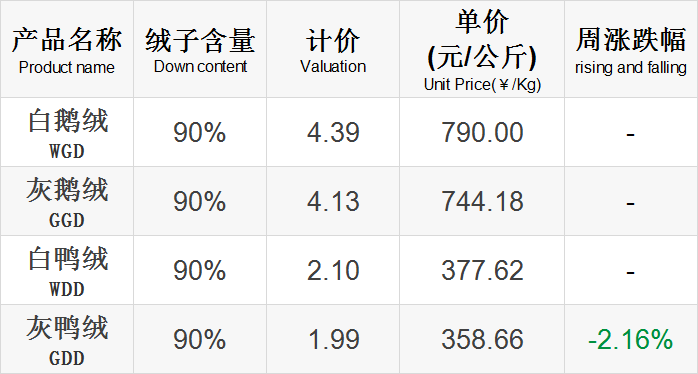Cn-down > Domestic news > News content
2023-08-06 来源:金绒 浏览量:1388
Summary
In the 32nd week of 2023 (7.31-8.6), the market is generally stable, with gray duck down falling slightly.

Since July 13, the U.S. dollar index has continued to rebound, rising by more than 2%, approaching 103 again, and triggered varying degrees of depreciation in the RMB, euro and Japanese yen.
As of August, there are still many spectators in downstream product companies. Now there is no support from orders, and down raw material transactions continue to remain light. And with the lower settlement price of duck feathers on July 6, the price of duck down has a trend of softening.
Order volumes for apparel, home textiles and technical textiles manufacturers improved significantly in July, according to a survey by the International Textile Manufacturers Federation (ITMF), while regional analysis showed Asia faced the greatest difficulties and South America was back on track.
Good news this week
In the first half of this year, under the influence of unfavorable factors such as weakening foreign demand and shifting orders, our country's foreign trade exports of down bedding (down quilts + other bedding) showed overall negative growth.
From January to June, our country's total exports of down bedding were US$199 million, a year-on-year decrease of 18.6%. However, down quilts have maintained rapid growth, with exports of US$93 million from January to June, a year-on-year increase of 43.6%.
Currently, the top four markets for my country's down bedding exports are the United States, the European Union, Japan and Australia.
In the first half of the year, exports to the United States were US$70.12 million, a year-on-year decrease of 14.4%; exports to the EU were US$37.52 million, a year-on-year decrease of 10.4%; exports to Japan were US$21.28 million, a year-on-year decrease of 25.2%; exports to Australia were US$14.59 million, a year-on-year decrease of 20.1%.

Zhejiang, Shanghai, Jiangsu, Anhui and Guangdong rank among the top five provinces and cities in the country for exporting down bedding.
In the first half of the year, Zhejiang’s exports were US$111 million, down 14.7% year-on-year; Shanghai’s exports were US$30.11 million, down 16.2%; Jiangsu’s exports were US$20.23 million, down 14.2%; Anhui's exports were US$19.55 million, a decrease of 16.4%; Guangdong's exports were US$8.73 million, a decrease of 12.5%.
According to international shipping data, the year-on-year decline in furniture products shipped from Asia to the United States in June has improved compared with May. In addition, before the back-to-school season in July and August, parents are preparing to increase spending on their children, and businesses are also offering discounts and promotions. It is expected that the sales of home textiles will start to rise in the second half of the year.
source |
金绒 数据来自海关
With crowded aisles, buyers pulling boxes to purchase goods, and merchants quickly packing and shipping goods, the Sijiqing Clothing Wholesale Market in Hangzhou, Zhejiang is a busy scene. The market is one of the country's largest clothing distribution bases and now receives more than 50,000 customers every day.
"At this time in previous years, there were basically no customers, but now there is an endless stream of customers every day. For professional packaging alone, we need four or five people."Wang Kaizhong, who has opened a store in Sijiqing for 5 years, said that although it is the off-season for the clothing market, the market popularity this year remains the same.
He also said that the sales volume in the store has also increased a lot, "the growth rate (year-on-year sales volume) is about 15%.Some old customers used to get 50,000 yuan or 80,000 yuan, but now they basically prepare for more than 10 to 200,000 yuan. "

Buyers said that they used to come once a month or half a month, and now they come more frequently every week or ten days.
More customers came to the door, which also gave merchants in the market more motivation and began to speed up product updates to attract customers.Compared with the traditional clothing wholesale market, more and more merchants in Sijiqingli are taking original routes.
According to data released by the National Bureau of Statistics, in the first half of the year, the cumulative retail sales of clothing, shoes, hats, knitwear, and textiles were 683.4 billion yuan, a year-on-year increase of 12.8%.
source |
央视财经
On July 31, data released by the National Bureau of Statistics showed that China’s official manufacturing purchasing managers index PMI in July was 49.3, higher than the expected 48.9 and the previous value of 49. The manufacturing boom level continues to improve.
In terms of enterprise size, the PMI of large enterprises was 50.3%, the same as the previous month; the PMI of medium-sized enterprises was 49.0%, an increase of 0.1 percentage points from the previous month; the PMI of small enterprises was 47.4%, an increase of 1.0 percentage points from the previous month.

From the perspective of sub-indices, among the five sub-indices that make up the manufacturing PMI, the production index and supplier delivery time index are higher than the critical point, while the new order index, raw material inventory index and employee index are lower than the critical point.
Among them, the new orders index rebounded sharply by 0.9 to 49.5, reaching the highest level since April this year, and the improvement speed was significantly accelerated compared with June. However, among other related indexes, the new export orders index was 46.3, down 0.1 percentage points, and the prosperity level showed little change.
source |
华尔街见闻
Bad news this week
According to statistics from the Mysteel agricultural product sample company, the average daily emergence of white-feathered commercial ducklings in July was about 11.6 million, a month-on-month increase of 15.77%. After 26-31 weeks into the year, moulting and reserve breeding ducks are still gradually increasing.The market is good and the number of breeding ducks to be eliminated is not large.
First of all, the impact of seasonal high temperatures on stocking has gradually weakened, and farmers are active in replenishing stocks at this stage; secondly, with the gradual reduction of subsidies at the end of the month, downstream manufacturers' stocking costs have reduced, and their enthusiasm for stocking has increased; finally, the industry is optimistic about the market situation from August to September. We have high expectations and are optimistic about the market outlook.
It is expected that the number of seedlings will reach a new peak in August without the industry's concentrated hunting for ducks.

Market outlook predicts that with the arrival of the school season in September, shipments of braised food products and frozen products from various frozen factories will slow down, and the volume of placement contracts will decrease; October will enter the off-season for product consumption, and placement efforts will be further reduced; there are many traditional festivals in November and December , product delivery is accelerated.
Judging from the current inventory of parental generation and the growth rate of commercial generation ducklings, the supply should be at a high level in the second half of the year, which is negative for the duckling market;judging from the elimination of parent breeding ducks, the current parent breeding duck market is supported by the egg market, and delays are increasing. It is expected that the number of eliminations will be limited in the second half of the year.
Moreover, the current production of end-of-breed ducks for slaughter is insufficient. In addition, catering and terminal market consumption has improved in the third and fourth quarters. The peak season for large-size products and segmented sales is approaching. The inventory pressure of frozen factories and dealers has improved. The enthusiasm for acquisitions has improved, and the amount of investment has increased. The demand side is good for the feathered duck market.
source |
Mysteel 农产品
One year after its implementation, on August 1, local time, the United States released the latest Uyghur Forced Labor Prevention Act (UFLPA).
The updated UFLPA emphasizes the enforcement of a “rebuttable presumption.” This presumption prohibits the import into the United States of goods produced in Xinjiang or produced by entities identified on the UFLPA Entity List unless the importer can prove by clear and convincing evidence.

In the first year of UFLPA, U.S. Customs and Border Protection (CBP) has reviewed more than 4,000 shipments worth more than $1.3 billion. Among them, at least 679 batches of goods have been refused entry, and nearly 2,000 batches of goods are still detained and need to go through a long review process before they can be released. CBP data shows that among the batches of goods detained as of March 14, electronic products ranked first, and textiles, clothing and footwear ranked second.
Despite increased enforcement efforts, members of Congress have expressed frustration with the speed and scope of U.S. Customs and Border Protection (CBP) enforcement operations over the past year, arguing that CBP has seized only a fraction of suspected commodity.
source |
美国贸易代表办公室
Although countries in the southern hemisphere are far away from the extreme summer temperatures in the northern hemisphere, Chile and Argentina both recorded record high temperatures in winter.
The temperature in Vicuña, a small mountain town in central Chile, has recently reached 37 degrees Celsius. Meteorologist Torres said that the last time such a temperature was recorded in Vicuña was more than 70 years ago. An unusually high temperature of 24 degrees Celsius was also recorded 450 kilometers south of Santiago, the capital of Chile.
At the same time, according to records from Argentina’s National Meteorological Service, the temperature in the capital Buenos Aires exceeded 30 degrees Celsius on August 1, setting the highest temperature for August 1 on record.The average temperature in Buenos Aires in August is usually between 9 and 18 degrees Celsius.

Cordello, a climatologist at the University of San Diego, believes that San Diego's high temperature record is likely to be broken this year, which is very abnormal. Ten years ago, the area experienced two heat waves per year; now there are nine.
Cordeiro noted that warmer weather will have the most significant impact on mountainous snowpack, which is important for the water supply of Chile's capital, Santiago. "Winter heatwaves have devastating effects on glaciers and snowfall," he said.
Experts say the Earth is experiencing a combination of two phenomena, global warming and El Niño. El Niño is characterized by rising ocean temperatures in the Pacific Ocean, causing rainfall, flooding, avalanches and heat waves in western South America.
source |
法新社
Market news situation
This week’s news is more negative than positive
In terms of exports, among other related indices of the manufacturing PMI, the new export orders index has been declining continuously since February, and the current export boom has repeatedly declined. In addition, the United States will also increase enforcement efforts to review Chinese imports.
In terms of terminals, although the wholesale market sentiment has rebounded, brand owners' wait-and-see sentiment may rise again due to the warm winter in the southern hemisphere, and the manufacturing PMI is still below the boom-bust line.
In terms of breeding, the production of white-feather commercial ducklings will reach a new peak in August, and the supply should be at a high level in the second half of the year, putting duck down prices under obvious pressure.
 热门排行
中国三大羽绒生产基地之—广东吴川
全球最奢侈羽绒服排行
一件羽绒服需要多少只鸭子的羽绒?
飞丝是什么?能代替羽绒?别被骗了,三种方法让你告别假羽绒服!
2017羽绒原料价格一路上涨,究竟为何?
你的羽绒服为什么钻绒?涨知识了
羽绒被的价格一般是多少 通过成本看羽绒被价格
中国羽绒服四大品牌调查:到底谁才是最强王者?
羽绒金网:羽毛、羽绒、毛绒计价
《羽绒羽毛》、《羽绒羽毛检验方法》新版标准发布,2017年7月1日实施
热门排行
中国三大羽绒生产基地之—广东吴川
全球最奢侈羽绒服排行
一件羽绒服需要多少只鸭子的羽绒?
飞丝是什么?能代替羽绒?别被骗了,三种方法让你告别假羽绒服!
2017羽绒原料价格一路上涨,究竟为何?
你的羽绒服为什么钻绒?涨知识了
羽绒被的价格一般是多少 通过成本看羽绒被价格
中国羽绒服四大品牌调查:到底谁才是最强王者?
羽绒金网:羽毛、羽绒、毛绒计价
《羽绒羽毛》、《羽绒羽毛检验方法》新版标准发布,2017年7月1日实施
 推荐阅读
“吴川力量”助中国羽绒接轨世界
中国三大羽绒生产基地之—广东吴川
中羽协第二期新国标培训班 在“羽绒之乡”广东吴川成功举办
羽绒之乡:贵港桥圩镇将打造旅游休闲特色小镇
广西贵港桥圩镇:打造中国羽绒休闲旅游特色小镇
羽绒金网:羽毛、羽绒、毛绒计价
羽绒别急着收 中央气象台发布寒潮蓝色预警 部分地区降温超12℃
上海消保委检测 千元鹅绒被用鸭毛绒填充
冻哭丨降温10℃!鸡年首个寒潮预警来袭,你准备好了吗?
传统羽绒产业如何实现转型升级?四川玉泉镇产业集群发展
推荐阅读
“吴川力量”助中国羽绒接轨世界
中国三大羽绒生产基地之—广东吴川
中羽协第二期新国标培训班 在“羽绒之乡”广东吴川成功举办
羽绒之乡:贵港桥圩镇将打造旅游休闲特色小镇
广西贵港桥圩镇:打造中国羽绒休闲旅游特色小镇
羽绒金网:羽毛、羽绒、毛绒计价
羽绒别急着收 中央气象台发布寒潮蓝色预警 部分地区降温超12℃
上海消保委检测 千元鹅绒被用鸭毛绒填充
冻哭丨降温10℃!鸡年首个寒潮预警来袭,你准备好了吗?
传统羽绒产业如何实现转型升级?四川玉泉镇产业集群发展